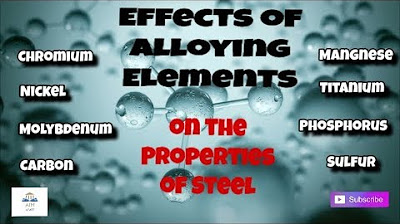Material Science, The Iron Carbon Phase Diagram, Part 1
Summary
TLDRIn this video, Professor Bonilla introduces the fundamental concept of the iron-carbon phase diagram, which forms the basis for understanding the properties of steel and cast iron. The diagram illustrates how iron transitions between different crystal structures—delta, gamma, and alpha—at various temperatures, influencing its mechanical properties. The interaction of carbon with iron leads to the formation of phases like cementite, which affects hardness and strength. This knowledge is essential for modifying the properties of steel and tailoring materials for specific engineering applications, with alloying elements further influencing microstructure and behavior.
Takeaways
- 😀 The iron-carbon phase diagram is essential for understanding the behavior and properties of steel and cast iron materials.
- 😀 Iron is a polymorphous metal, existing in different crystal structures: body-centered cubic (BCC) and face-centered cubic (FCC), depending on the temperature.
- 😀 The iron-carbon system allows the formation of various materials by altering the temperature and carbon content, providing wide-ranging mechanical properties for steel and cast iron.
- 😀 The key phases in the iron-carbon system are ferrite (alpha iron), austenite (gamma iron), and cementite (Fe₃C).
- 😀 Carbon solubility in iron varies across different phases, with higher solubility in austenite (up to 2.06%) compared to ferrite (up to 0.02%).
- 😀 The Curie temperature (769°C) marks the point at which iron loses its ferromagnetic properties, becoming paramagnetic.
- 😀 The eutectoid transformation at 0.8% carbon and 723°C leads to the formation of pearlite, a mixture of ferrite and cementite.
- 😀 The eutectic system, occurring at 4.3% carbon and 1147°C, results in the formation of ledeburite, which is a mixture of austenite and cementite.
- 😀 Cementite plays a crucial role in determining the strength and hardness of steel but reduces ductility, making it a brittle phase at high concentrations.
- 😀 The phase diagram can be divided into stable and metastable systems, with the metastable system being more relevant to steel production due to its cementite content.
Q & A
What is the iron-carbon phase diagram often referred to as in material science?
-The iron-carbon phase diagram is often referred to as the 'Mona Lisa' of material science due to its significance in understanding steel and cast iron materials.
What role does carbon play in iron in terms of its properties?
-Carbon interacts with the two crystal structures of iron—body-centered cubic (BCC) and face-centered cubic (FCC)—and can influence the mechanical properties of steel and cast iron by changing their strength, hardness, and other characteristics.
What is the maximum carbon content in steel as defined by the European Standard EN 10020?
-According to EN 10020, steel is defined as a material consisting mostly of iron with a maximum carbon content of 2%.
Why is iron considered a polymorphous metal?
-Iron is considered a polymorphous metal because it exists in different types of crystals, namely delta iron (BCC), gamma iron (FCC), and alpha iron (BCC), each with distinct properties.
What are the key temperature points at which iron transitions between crystal structures?
-Iron transitions between crystal structures at specific temperature points: delta iron forms at 1536°C, gamma iron forms at 1401°C, and alpha iron forms at 911°C. Each transition marks a change in the structure and properties of the material.
What is the significance of the Curie temperature in iron?
-The Curie temperature of iron is 769°C, above which iron loses its ferromagnetic properties and becomes paramagnetic, marking a change in its magnetic behavior.
What is the difference between ferrite and austenite in terms of their crystal structure and properties?
-Ferrite (alpha iron) has a body-centered cubic (BCC) lattice and is magnetic, while austenite (gamma iron) has a face-centered cubic (FCC) structure, is non-magnetic, and is more ductile, allowing it to absorb more carbon in solution.
How does the iron-carbon phase diagram define the solubility of carbon in iron?
-In the iron-carbon phase diagram, carbon solubility varies depending on the phase. Ferrite (alpha iron) can dissolve up to 0.02% carbon, while austenite (gamma iron) can dissolve up to 2.06% carbon, due to differences in their crystal structures and lattice vacancies.
What is cementite, and why is it important in the iron-carbon phase diagram?
-Cementite (Fe₃C) is an intermetallic compound of iron and carbon that plays a crucial role in steel's hardness and strength. It forms at higher carbon contents and contributes to the brittleness of the material.
What are the eutectic and eutectoid points in the iron-carbon phase diagram, and what do they represent?
-The eutectic point at 4.3% carbon and 1147°C leads to the formation of cementite and austenite, creating a hard but brittle structure. The eutectoid point at 0.8% carbon and 723°C results in the formation of pearlite, a lamellar structure that increases strength and hardness.
Outlines

This section is available to paid users only. Please upgrade to access this part.
Upgrade NowMindmap

This section is available to paid users only. Please upgrade to access this part.
Upgrade NowKeywords

This section is available to paid users only. Please upgrade to access this part.
Upgrade NowHighlights

This section is available to paid users only. Please upgrade to access this part.
Upgrade NowTranscripts

This section is available to paid users only. Please upgrade to access this part.
Upgrade NowBrowse More Related Video

Torsion Test Demonstration: Cast Iron and Carbon Steel

Steel Metallurgy - Principles of Metallurgy

Complete Steel Making Process in easy steps ll. TATA VOCATIONAL TRAINING

Why is the carbon content in steel so important?

The Extraction of Iron (GCSE Chemistry)

Effects of alloying Elements on the Properties of steel. ||Engineer's Academy||
5.0 / 5 (0 votes)